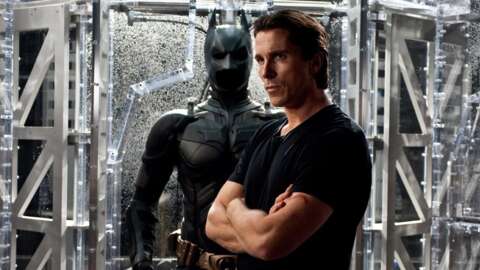“The greatest horror movie of all time.” It’s a common refrain in discussions of 1973’s The Exorcist, the first horror film ever to be nominated for Best Picture at the Oscars. It legitimized, elevated, and influenced the genre in ways that are so pervasive, it can be difficult to revisit without thinking about the weight of its reputation. But at The Exorcist’s heart was a deceptively simple story of a mother with all the money in the world, with access to the best doctors in Washington DC, all of whom come to the conclusion that whatever is plaguing Regan MacNeil will take a priest to combat. Five years later, John Carpenter’s Halloween ushered in a new generation of horror built on even barer bones – mask, knife, and another innocent girl in the crosshairs of pure evil – and now both cinematic landmarks have been revived and streamlined by director David Gordon Green.
But whereas 2018’s Halloween set up a reckoning for Laurie Strode, her family, and her hometown that was inextricably tied to Michael Myers’ original killing spree, The Exorcist: Believer doesn’t have as clear a perspective into how the specifics of Regan’s possession are reverberating into the present day. That leaves Believer feeling relatively adrift and struggling to keep pace with the legions of imitators and innovators the original Exorcist inspired.
Believer follows the broad strokes of the original’s structure, which 50 years of homage should render predictable. Victor Fielding (Leslie Odom Jr.) is an atheist widower, and overprotective of his 13-year-old daughter Angela (Lidya Jewett), who yearns for a little more breathing room. It’s a basic enough father-daughter dynamic to drop a demonic possession into – how Angela’s growing up feels like the scariest thing in the world to Victor, especially after her mother’s passing. Katherine (Olivia O’Neill) is similarly sheltered by devoutly Catholic parents Miranda and Tony (Jennifer Nettles and Norbert Leo Butz). Angela and Katherine have clearly bonded over being helicopter parented, and it's their shared rebellious streak that has them sneaking out to the woods to explore drain pipes and attempt contact with the spirit world, a guaranteed recipe for a bad time in a horror movie and one that leads to the girls disappearing for days without explanation as to where they could’ve gone.
Much of The Exorcist’s potency – and why the movie still works today – comes from the indomitable power of suggestion. Believer does a much better job of weaponizing what we’re not seeing in its first half, especially in the too-brief window of screen time where the girls’ disappearance is unresolved, and Green gets off to a strong start in building tension and dread. Angela and Victor’s close relationship, in spite of Victor’s zealous parenting, is charming, and the unanswered questions about Angela’s whereabouts give Odom a number of opportunities to play Victor’s bottled anxiety with immediacy. Green stages some creepy scenes in these early stages, where the girls’ true personalities are still close to the surface and influencing their actions – fingernail biting gets deployed in a particularly nasty way here. The horror is supported throughout by strong cinematography and sound design, which, at their best, evoke the surreal oppressiveness of William Friedkin’s original, while never quite standing shoulder to shoulder with it. A lot of the tension bleeds away once the girls return and have to battle back their inner demons – or, more accurately, their inner demon.
The Exorcist: Believer takes a risk by introducing the concept of synchronized possession, an idea that works better in theory than in practice. The presence of two possession victims opens up a conversation about how disparate belief systems (or lack thereof) serve as a source of conflict and salvation under these extraordinarily trying circumstances, which is an interesting angle from a thematic standpoint. But while that may be the source of some interesting drama, it’s never applied to the film’s scares with much imagination. Each girl commits acts of heresy and violence, but Angela and Katherine spend most of the second act separated while succumbing to their demonic intruders. Few of the girls’ episodes feel especially tied to what the other is doing or has done, so their shared possession starts to just feel less “synchronized” and more “concurrent.”
Believer feels like it’s trying to get by on a “double the possession, double the fun” pitch that it never really delivers on. Jewett and O’Neill give enthusiastic, operatic performances, but with little to differentiate their cases, their plights become interchangeable and hard to get too emotionally invested in. That’s not helped by Believer picking a favorite kid early on: The Fieldings’ perspective on the possession is home base, with Katherine and her family (no, they don’t get last names) being undercooked seemingly by design. That feels like a miscalculation given how important the connection of their cases is. Unlike the original film, which really draws out Regan’s decline and underlines how that affects her mother Chris, Angela and Katherine’s personalities are almost instantly swept away by their nondescript tormenter. That moves the entire emotional weight of their salvation to the parents too quickly, and despite Nettles and Butz doing skillful work keeping Miranda and Tony from feeling too blindly dogmatic in their faith, it means that every miscalculation made in saving the girls feels especially grating.
Aside from reinterpreting and reusing some of The Exorcist’s iconography, Believer’s most significant tie to the original story is the appearance of Ellen Burstyn’s Chris MacNeil. It’s a shame that her involvement in this story borders on superfluous. Chris has become an expert in exorcism after Regan’s possession, and Burstyn gamely provides some stakes-setting doomsaying in advance of the third act, but her scenes feel out of step with the story being told and in some cases actively work against the tension building as Angela and Katherine’s conditions worsen. Chris’ estrangement from Regan gets some lip service to complicate the assistance she gives Victor, but as a stand-in for Max Von Sydow’s confident Father Merrin, she feels a little lost.
With the missed opportunity of Burstyn’s return, Believer needs to nail the only other thing that justifies its Exorcist pedigree: the extended exorcism climax. The third act ends up being the movie in microcosm: some occasional strong imagery and ideas, but executed without enough focus to bring them all together. Community is at the heart of Believer’s story: The stage for the girls’ survival is set by their parents’ willingness to accept support from across the ideological spectrum. The lonely Victor’s new and deepening relationships with his neighbors give him strength and an openness of mind that Odom’s reluctant and guarded performance tracks well. The exorcism task force that he helps put together may be representative of a wide swath of belief systems, and effective enough at presenting an easily digestible morality play, but in practice, the pantheistic approach is a little too chaotic. The supporting players are too briefly introduced and too thinly developed throughout Believer to make their presence during the exorcism feel gratifying, with the exception of Victor’s neighbor Ann, who ends up with the film’s most successful character arc by some measure. As portrayed by Ann Dowd, Ann has a complicated history with her faith that becomes one of the few reliable sources of tension in the third act, thanks largely to Dowd’s lovely and emotionally grounded performance.
The cacophony of different approaches to battling the demon, and the chaos of which rite is or isn’t working and when, makes the first half of the exorcism difficult to follow. These different belief systems working in tandem may serve the overall themes of Believer, but as an engine for the finale, they lack the simplicity and legibility of two priests, a demon, and the power of Christ which compels it. A pause in the efforts serves as a sort of halftime to readjust the approach, with Green tying the girls’ fates into difficult choices their parents must make, and things improve from there as the stakes become more easily tracked. Angela and Katherine surface just long enough to turn the screw on their parents during this sequence, giving Jewett and O’Neill their best shots at playing the horror of what their experience has been up to this moment, and the fear of what’s to come should the rite fail.







